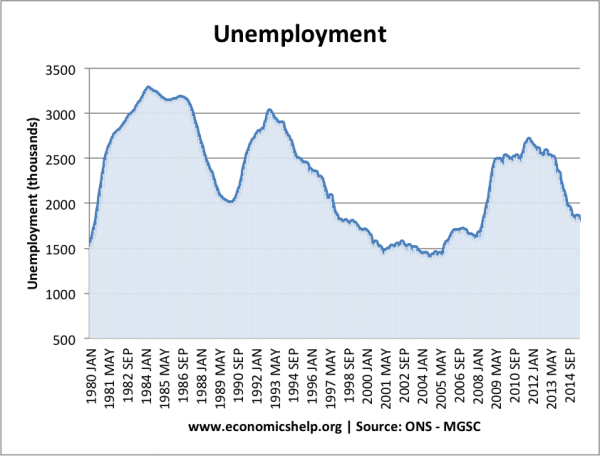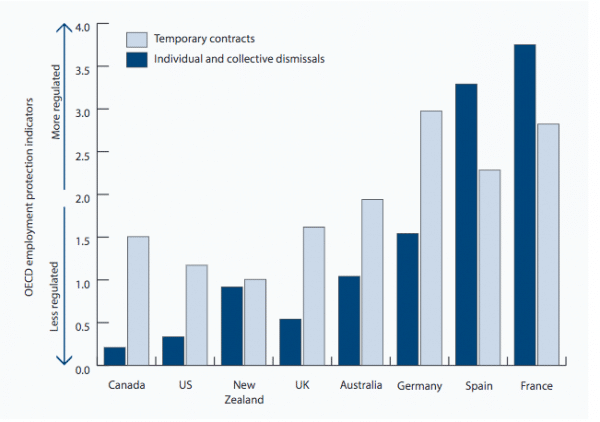Flexible Labour Markets mean that the labour markets quickly adjust to a competitive equilibrium. Flexible labour markets involve factors such as:
- Easy to hire and fire workers.
- Labour is occupationally and geographically mobile.
- Government intervention does not distort the market.
Characteristics of flexible markets
- A skilled workforce which can adapt to changing requirements.
- Flexible hours and working contracts e.g. more temporary employment or working from home.
- Self-employment where workers and firms can be more flexible in how and when to work.
- Labour markets are competitive.
- Greater flexibility in pay arrangements.
- Non-unionised workforce
Why has there been an increase in labour market flexibility?
- Globalisation has opened the UK to more international competition, therefore, to remain competitive firms have to keep labour costs relatively low and have sought to use more flexible labour contracts to keep labour affordable.
- Technological change has made it easier to have flexible labour markets. For example, the internet has increased the ability for people to work from home or set up their own self-employment business.
- Changing social environment e.g. increased female participation in the labour force, women are more likely to favour part-time, flexible work. Also, an ageing population has led to an increase in ‘semi-retirement’ with older workers choosing to work part-time
- Core-periphery model. This states that firms are making more use of a core workforce but also part-time temporary workers who are more flexible.
- Privatisation. Private firms have sought to increase profitability by cutting excess workers and inflexible labour contracts.
- Reduced power of trades unions such as banning closed shops and limitations on the right to picket.
- Harder to get unemployment benefits.
- Growth in self-employment – more people classed as self-employed rather than employed
- Increased migration, e.g. workers from Eastern Europe coming to the UK to fill labour shortages.
- The rise in the gig economy. The Internet has enabled people to hold numerous jobs at the same time. For example, the taxi driver who works for a local company and Uber.
Impact of flexible labour markets

- Helps to reduce unemployment. Post-2009 recession, unemployment fell much quicker than after previous recessions. Many attribute this to more flexible labour markets. See UK Unemployment mystery
- Lower wage growth. More flexible labour markets can help firms keep wages low. Since 2009, the UK has seen stagnant real wage growth
- More job uncertainty. Greater flexibility can lead to more zero-hour contracts where workers have no guarantee of weekly hours, leading to underemployment.
- Poor labour productivity. The UK has suffered from poor labour productivity. This could be due to many factors, but increased labour market flexibility may discourage firms from investing in human capital. If workers are on short-term contracts then investment could end up being wasted.
- Helps to act as an automatic stabiliser. In a booming economy, a flexible labour market can more easily respond to rising demand. For example, in the Irish boom of 2000-2007 many migrant construction workers came from Eastern Europe. But, in the recession, many of these workers left – mitigating the rise in Irish unemployment.
- Increased profitability. More flexible labour markets help to reduce firms costs – wages are lower and they can employ workers for fewer hours. In recent years, company profit has taken a bigger share of GDP, whilst wage inc.me has fallen as a share of GDP>
How flexible is the UK Labour Market?
- Source: CER Feb. 2016
The UK has relatively light labour market regulation compared to European countries, such as Germany, Spain and France.
The UK has also seen a fall in the official unemployment rate, but also it has seen.
Policies to increase labour market flexibility
- Subsidised childcare provision – increase the incentive for women to work.
- Increased spending on education and training
- Reducing the power of trades unions and minimum wages
- Making it easier to hire and fire workers.
- Subsidies to enable people to move around the country
- Building more houses to reduce the cost of renting and make it easier to move.
See also: More policies to increase labour market flexibility
Related

